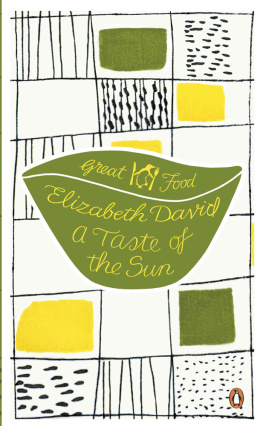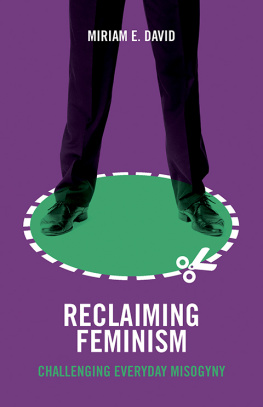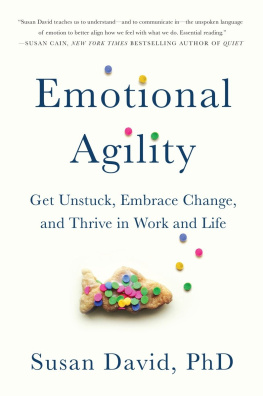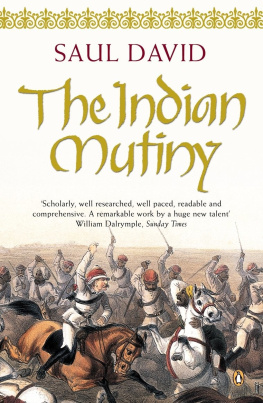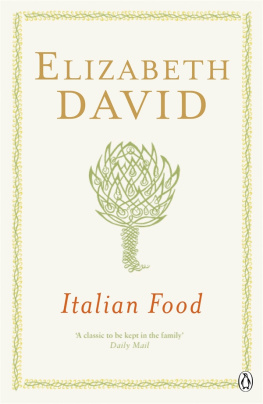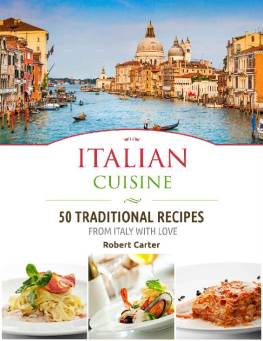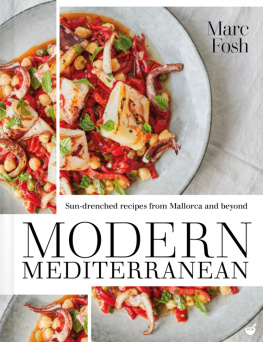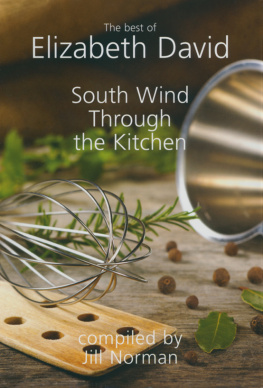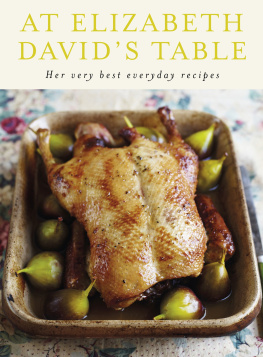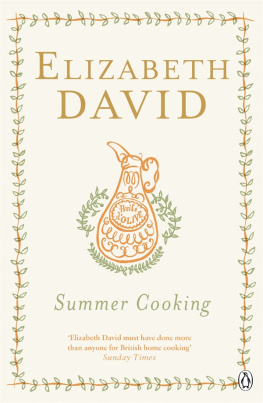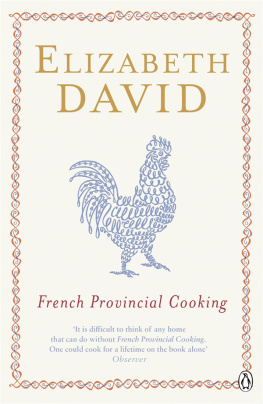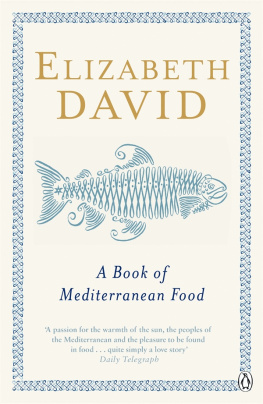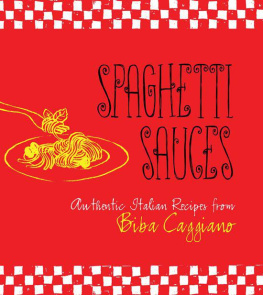A Taste of the Sun
ELIZABETH DAVID
PENGUIN BOOKS
PENGUIN BOOKS
Published by the Penguin Group
Penguin Books Ltd, 80 Strand, London WC2R 0RL, England
Penguin Group (USA) Inc., 375 Hudson Street, New York, New York 10014, USA
Penguin Group (Canada), 90 Eglinton Avenue East, Suite 700, Toronto, Ontario, Canada M4P 2Y3 (a division of Pearson Penguin Canada Inc.)
Penguin Ireland, 25 St Stephens Green, Dublin 2, Ireland
(a division of Penguin Books Ltd)
Penguin Group (Australia), 250 Camberwell Road, Camberwell, Victoria 3124, Australia
(a division of Pearson Australia Group Pty Ltd)
Penguin Books India Pvt Ltd, 11 Community Centre, Panchsheel Park, New Delhi 110 017, India
Penguin Group (NZ), 67 Apollo Drive, Rosedale, Auckland 0632, New Zealand
(a division of Pearson New Zealand Ltd)
Penguin Books (South Africa) (Pty) Ltd, 24 Sturdee Avenue, Rosebank, Johannesburg 2196, South Africa
Penguin Books Ltd, Registered Offices: 80 Strand, London WC2R 0RL, England
www.penguin.com
This collection published in Penguin Books 2011
Copyright the Estate of Elizabeth David, 2011
All rights reserved
These extracts have previously been published in French Country Cooking, Of Pageants and Picnics, Italian Food, Is There a Nutmeg in the House?, French Provincial Cooking, English Bread and Yeast Cookery and An Omelette and a Glass of Wine, all published by Penguin Books
Cover design based on a pattern from a Chequers design plate by Terence Conran for Midwinter Modern, c. 1954. (Photograph copyright Victoria & Albert Museum.) Picture research by Samantha Johnson. Lettering by Stephen Raw
Except in the United States of America, this book is sold subject to the condition that it shall not, by way of trade or otherwise, be lent, re-sold, hired out, or otherwise circulated without the publishers prior consent in any form of binding or cover other than that in which it is published and without a similar condition including this condition being imposed on the subsequent purchaser
ISBN: 978-0-14-196598-7
PENGUIN BOOKS GREAT FOOD
A Taste of the Sun
ELIZABETH DAVID (19131992) was a legendary writer and cook. Living in Greece at the outbreak of the Second World War, she did not return to Britain until peace was declared. She found the country worn down by rationing and dull food. In 1950 she published Mediterranean Food, which, along with subsequent books including Italian Food and French Provincial Cooking, changed the face of cookery in Britain for ever. In her later works she explored the traditions of English cooking. She received many honours, including a CBE in 1986. She is widely considered Britains greatest twentieth-century cookery writer, and her books today continue to inspire many, who find her philosophy of simplicity, authenticity, knowledge and care to their liking.
USEFUL ADVICE
Batterie de Cuisine
Delicious meals can, as everybody knows, be cooked with the sole aid of a blackened frying-pan over a primus stove, a campfire, a gas-ring or even a methylated spirit lamp. This book, however, is for those whose ambitions lie in the direction ofsomething less primitive in the way of food, so the question of stocking the kitchen with good pans and the right implementsis of the first importance.
If you are starting from scratch, the most satisfactory method is to see that you have the basic necessities to begin withand buy gradually as you find out which style of cooking best suits your talents. (If, for example, you have no particularflair for cakes and pastries, it is pointless to clutter up the kitchen with a whole range of pastry boards, cake tins, tartletmoulds and icing sets.)
One thing is quite certain, and that is that if Englishwomen paid more attention to having the right equipment in their kitchens,we should hear a great deal less about the terrible labour of good cooking. How many times have I been told: Oh, I haventtime to fiddle about with that kind of thing, just because a recipe called for putting something through a sieve or choppingup a few vegetables. Dont hamper your cooking and waste time and materials through lack of the right tools for the job.
First, and these are essential to any kitchen, come the very best quality of cooks knives. You need a small vegetable knife,razor sharp, a medium one for trimming meat and fish (known as a filleting knife), a large one for cutting up meat and poultry,and a long, thin-bladed ham knife for cold meat, and anything which has to be thinly sliced. A first-class bread knife goeswithout saying; keep it for bread. Take the greatest care of your knives; dont cut with them on an enamel or marble-toppedtable or a plate; have a good steel for sharpening; keep your kitchen knives in a special box or compartment of the knifedrawer; wash, dry, and put them away, with the points stuck into a cork, as soon as you have finished with them. Let it beunderstood by all members of the household that there will be serious trouble if your knives are borrowed for screwdriving,prising open packing-cases, cutting fuse wire or any other purpose for which they were not intended.
[]
A straightforward saucepan of 12 pint capacity, of heavy quality and with a well-balanced handle, is an asset to anyone whointends to practise serious sauce-making. If this pan is to be a copper one, it is important that the tinning be kept in goodcondition, so for stirring use a wooden spoon or spatula rather than a whisk which scratches and quickly wears out the tin.
The more experienced cook, progressing to specialized work, may want to invest in the traditional untinned hemispherical copperegg bowl which is unequalled for the successful beating of egg whites but not easy to keep in immaculate condition. An untinnedheavy quality (and unless it is heavy quality, a minimum of one-sixteenth of an inch thick, dont bother with it) preserving pan is another worthwhile buy,and so, for the ambitious pastry cook or confectioner, is an untinned, lipped, sugar-boiling pan. It should be noted thatit is because the melting point of tin is lower than the boiling point of sugar that copper pans for jam-making, confectioneryand sugar-work generally are never tinned. To clean untinned copper, rub with a cut lemon dipped in fine salt, or with a softrag dipped in a strong solution of vinegar and salt.
[]
Heavy copper, cast aluminium, and cast iron pans with machine-turned bases are all suitable for all types of cooking stoves.So is stainless steel, but it is a bad heat conductor and to be efficient a stainless steel pan must be heavily copper-cladon the base, which makes for enormous and, it seems to me, unnecessary expense.
Whether you choose cast aluminium, enamelled steel, tinned copper, enamelled cast iron or stainless steel, be sure to haveat least two deep stew pans, one large and one small, with a small handle at each side; in these all manner of soups and stewscan be put in the oven as well as on top of the stove, an essential requirement for anyone who has other duties than thoseof a cook to attend to. For boiling potatoes keep one special pan with an enamel lining. Another essential is a shallow ovalor round fire-proof pan which will go under the grill or in a very hot oven for dishes which are to be browned quickly. Onelarge pan of a minimum 1 gallon capacity is a necessity for cooking rice and spaghetti, and for anything over four people you must have a still larger one, say 2 to 3 gallons capacity, and this will do for the boilingof chickens and for making stock. Shallow, two-handled pots from seven to ten inches in diameter and about three inches deepfor risotto, pot roasts, various forms of ragots and vegetable dishes are a blessing. These can be found in copper, castaluminium or, better still, enamel-lined cast iron with machine-turned bases.

